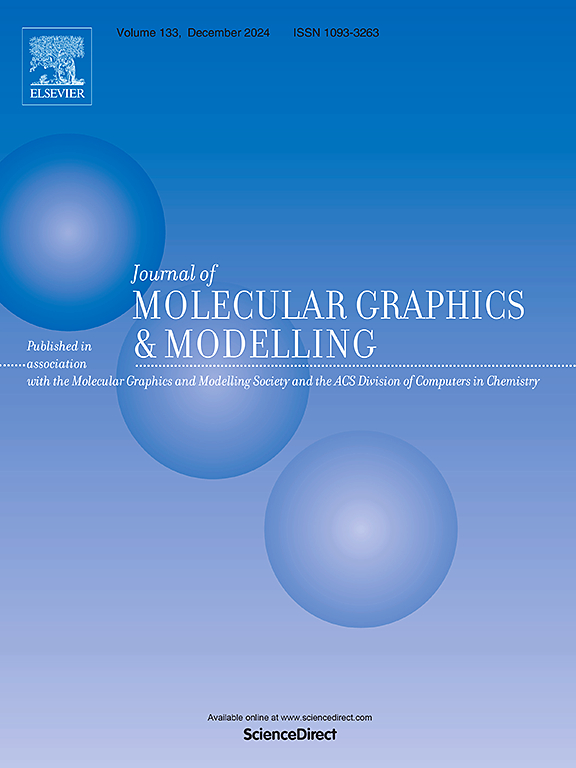Molecular dynamics investigation of cysteine mutations: Effects on calcium ion affinity and structural stability in the RET cysteine-rich domain
IF 3
4区 生物学
Q2 BIOCHEMICAL RESEARCH METHODS
引用次数: 0
Abstract
The RET receptor tyrosine kinase is essential for cell growth, differentiation, and survival. Its cysteine-rich domain (CRD) is crucial for ligand-induced dimerization, activation, and structural stability, significantly influenced by calcium ion coordination. Mutations in key cysteine residues can disrupt disulfide bonds, alter calcium binding, and destabilize the CRD, leading to oncogenic transformations. This study investigates the impact of cysteine mutations on calcium ion binding and the structural stability of the RET receptor's CRD. Using molecular dynamics simulations and free energy calculations, the research examines the structural effects of specific cysteine mutations (C565F, C581F, and C585S) in the CRD. The findings indicate that these mutations disrupt disulfide bonds, alter calcium binding, and destabilize the CRD. RMSD and RMSF analyses show that each mutant affects structural dynamics and flexibility differently. The C581F mutant exhibited the most significant effect, with average RMSD values of 0.21 nm compared to the wild-type (0.19 nm) and other mutants (C565F, 0.14 nm; C585S, 0.17 nm). Higher residue fluctuations were observed in C581F and C585S, particularly in the calcium-coordinating residues. Binding free energy analysis indicates reduced calcium-binding stability in the mutants, while weighted contact maps reveal altered residue interaction patterns and new contact formations. These results suggest that while global structural changes are minimal, cysteine mutations cause localized destabilization of calcium ion binding sites. The disruption of key disulfide bonds and reduced residue contacts likely contribute to decreased binding stability in the mutants, underscoring the importance of cysteine residues and calcium coordination in maintaining the integrity of the RET-CRD.

半胱氨酸突变的分子动力学研究:对RET富含半胱氨酸区域钙离子亲和力和结构稳定性的影响
RET受体酪氨酸激酶对细胞生长、分化和存活至关重要。其富含半胱氨酸的结构域(CRD)对配体诱导的二聚化、活化和结构稳定性至关重要,受钙离子配位的显著影响。关键半胱氨酸残基的突变可以破坏二硫键,改变钙结合,使CRD不稳定,导致致癌转化。本研究探讨了半胱氨酸突变对钙离子结合和RET受体CRD结构稳定性的影响。利用分子动力学模拟和自由能计算,研究了CRD中特定半胱氨酸突变(C565F、C581F和C585S)的结构效应。研究结果表明,这些突变破坏了二硫键,改变了钙结合,并使CRD不稳定。RMSD和RMSF分析表明,每个突变体对结构动力学和柔韧性的影响是不同的。C581F突变体的影响最为显著,平均RMSD值为0.21 nm,高于野生型(0.19 nm)和其他突变体(C565F, 0.14 nm;C585S, 0.17 nm)。C581F和C585S的残基波动较大,尤其是钙配位残基。结合自由能分析表明突变体的钙结合稳定性降低,而加权接触图揭示了残基相互作用模式的改变和新的接触形成。这些结果表明,虽然整体结构变化很小,但半胱氨酸突变会导致钙离子结合位点的局部不稳定。关键二硫键的破坏和残基接触的减少可能导致突变体结合稳定性下降,强调了半胱氨酸残基和钙协调在维持RET-CRD完整性中的重要性。
本文章由计算机程序翻译,如有差异,请以英文原文为准。
求助全文
约1分钟内获得全文
求助全文
来源期刊

Journal of molecular graphics & modelling
生物-计算机:跨学科应用
CiteScore
5.50
自引率
6.90%
发文量
216
审稿时长
35 days
期刊介绍:
The Journal of Molecular Graphics and Modelling is devoted to the publication of papers on the uses of computers in theoretical investigations of molecular structure, function, interaction, and design. The scope of the journal includes all aspects of molecular modeling and computational chemistry, including, for instance, the study of molecular shape and properties, molecular simulations, protein and polymer engineering, drug design, materials design, structure-activity and structure-property relationships, database mining, and compound library design.
As a primary research journal, JMGM seeks to bring new knowledge to the attention of our readers. As such, submissions to the journal need to not only report results, but must draw conclusions and explore implications of the work presented. Authors are strongly encouraged to bear this in mind when preparing manuscripts. Routine applications of standard modelling approaches, providing only very limited new scientific insight, will not meet our criteria for publication. Reproducibility of reported calculations is an important issue. Wherever possible, we urge authors to enhance their papers with Supplementary Data, for example, in QSAR studies machine-readable versions of molecular datasets or in the development of new force-field parameters versions of the topology and force field parameter files. Routine applications of existing methods that do not lead to genuinely new insight will not be considered.
 求助内容:
求助内容: 应助结果提醒方式:
应助结果提醒方式:


